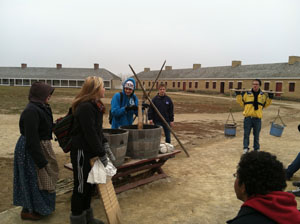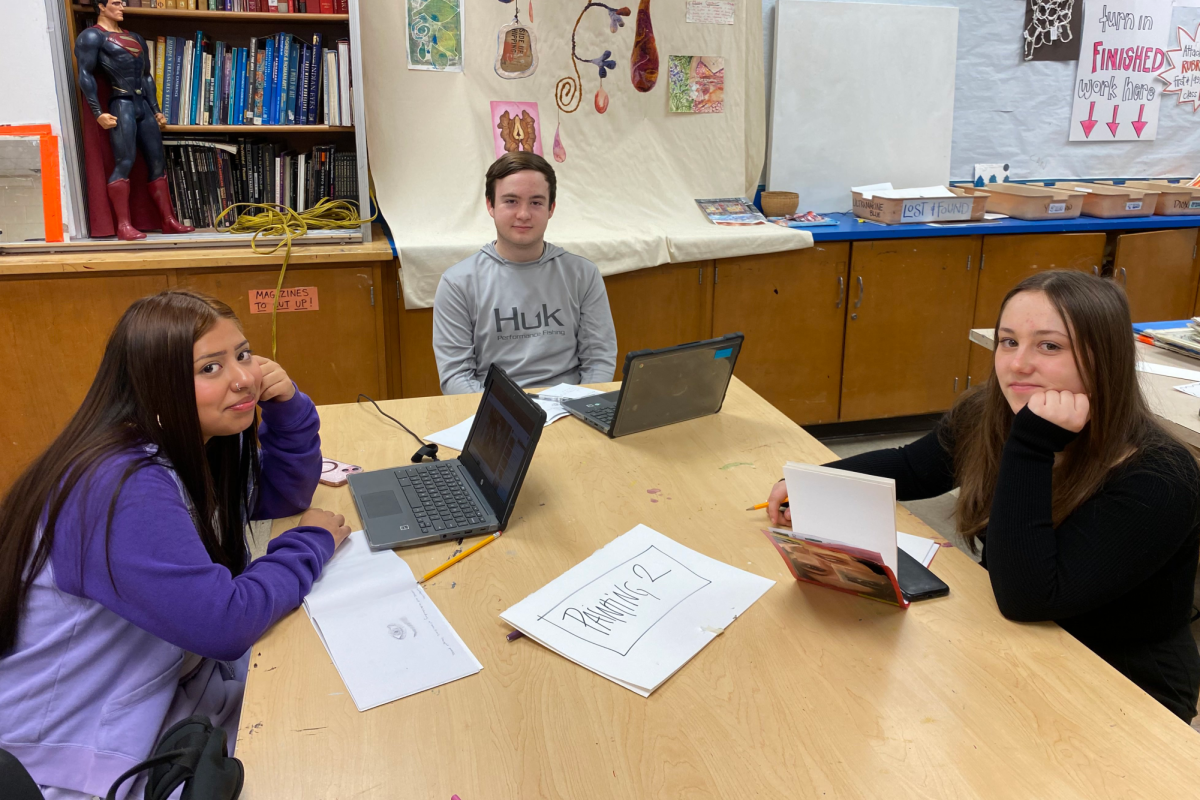Unresolved conflicts remain 150 years after the US-Dakota War

October 26, 2012
 “We will never forget,” declared Junior Sean Buehlmann. Buehlmann is part of the Dakota community, and what she will never forget is the US Dakota War of 1862. While the war is still a big part of Buehlmann and other Dakota people’s lives, it has only recently come into the thoughts of most Minnesotans due to the fact that this year is the 150th anniversary of the war.
“We will never forget,” declared Junior Sean Buehlmann. Buehlmann is part of the Dakota community, and what she will never forget is the US Dakota War of 1862. While the war is still a big part of Buehlmann and other Dakota people’s lives, it has only recently come into the thoughts of most Minnesotans due to the fact that this year is the 150th anniversary of the war.
Broken treaty promises and U.S Indian policies set the scene for the six week long war. The Dakota were forced to sign treaties giving up their land and had to rely on the government for food. The government failed to follow through with providing provisions, and in the summer of 1862 the Dakota were struggling with starvation.
On August 17, 1862, four Dakota men killed 5 settlers, and that spark ignited the war. Throughout those six weeks 400-600 white settlers and soldiers were killed, but the number of Dakota killed was never documented. On December 26, 1862, three months after Henry Sibley and his troops defeated the Dakota, 38 Dakota men hung in Mankato. This was the largest mass execution in U.S history. While only 38 men were hung, 300 were originally sentenced to this fate. However, President Lincoln declared that 264 of these men were to face prison time.
After fighting for six months for their land, the Dakota’s struggles were not over. In the winter between 1862 and 1863, around 1,600 non-combatant Dakota were held at a concentration camp at Fort Snelling. During this cold winter nearly 300 Dakota died, most of them women, children and the elderly. In March of 1863, a law was passed calling for the banishment of Dakota people from Minnesota. The prisoners at Fort Snelling and those remaining in Mankato were transported via the Mississippi to Iowa and Nebraska.
Once every year since 2006, Dakota people come from near and far to participate in a commemorative march. The march begins at the Lower Sioux Agency in Morton, Minnesota where the first organized attack of the war took place and ends at Fort Snelling, tracing the path that the Dakota were moved.
“For a week we would go on this walk and follow their footsteps,” explained Buehlmann, “It was really empowering.” According to Buehlmann, they would walk 20 miles a day, and at every mile they would place a marker in honor of someone who died in the war.
When Buehlmann was 11 she went on the march for the first time with her dad. She remembered thinking, “you’re a Dakota person and all these people suffered for you to be here.” Buehlmann noted that being on the march was like going back in time, “you really get a sense of the family and the social part of how people interacted.”
The Minnesota Historical society took this idea of ‘going back in time’ a little further when they decided to create an exhibit at the Minnesota History Center about the war. “A big goal was to get across the chain of events that led to this war,” said Dan Spock, Director of the Minnesota History Center, “and another goal is to show how the war, like all wars, has a durable impact on people’s lives, usually a traumatic negative impact.”
While this war was traumatic for Dakota people, and they are still feeling the aftermath, it also affected white settlers and current residents of Minnesota. “It’s a fundamental story in understanding how the state came to be and how it got started,” stated Spock. “One of the key things to stress is that the war was a product of United States policies that went ary,” said Spock.
Spock explained that the United States had a policy to expand across North America until they had filled it all, and in order to do this they needed to push out the Native people. The government tried to make what they were doing seem legitimate and legal, however “when you start to dig into it you realize that Native people didn’t have a lot of choices going into these treaty negotiations,” added Spock.
When the exhibit was announced, some Dakota people were not so thrilled. “It really has to do with who has the power in how history is told,” said Spock about the Dakota’s cautious approach of the topic, “for Dakota people their experience has been that white people have been able to tell this story.” While the United States used text to keep their history, “Dakota traditions are oral traditions, stories are passed along person to person, so their sense is that the written record that exists does not fairly represent their experience,” expressed Spock. Spock stressed the importance of trust when going into conversation about the war and other sensitive topics with the Dakota. “For Dakota people there are some conflicting desires,” said Spock, “but partially there is a desire that people know and understand the truth, particularly people who are white, that they understand the high price that they paid for us living here in the state of Minnesota.”
Pow Wow Grounds, a Native American coffee shop in Minneapolis held an art exhibit about the war. “It was probably one of the most deep art shows I’ve ever seen,” shared senior and Pow Wow Grounds employee Winona Vizenor. The art exhibit included pieces about the war and the hangings in Mankota. Vizenor noted that many people were unaware of the war before seeing the art exhibit, and many left in tears. “Even as an Ojibwe person, knowing that happened to Dakota people, those are still other Native Americans. That’s still connected to me,” shared Vizenor, “It makes me mad because that’s how other Native American people were treated.”
The Minnesota Historical Society was established in 1849, and over the years they have collected many artifacts and documents. According to Spock, about 1,000 of those are Dakota related. While only a small number of these were relevant to the exhibit, many were not used out of respect of Dakota requests. “What they were trying to display was ceremonial items,” said Buehlmann, and this did not fit with Dakota customs. “Personal items of people who are dead shouldn’t be put on display,” shared Buehlmann, “it’s disrespectful to the dead.”
Through the process of creating the exhibit, the Historical Society became aware that the Dakota didn’t have a good sense of what was held in the collection. “(The Dakota) really felt like it would be premature of us to put anything on exhibit until they really got an opportunity to review what we had,” said Spock. The database that is used to find these items is very difficult to use, but as part of this exhibit the historical society revamped the database in order to make it Dakota accessible.
According to Spock, the next step in dealing with the Dakota related collection is repatriation. “Repatriation is a term that is used in museum practice where things that have belonged to a culture and been acquired or taken, sometimes stolen, historically it’s a process by which those things are returned to their original owners,” said Spock. 61 objects have been identified as needing repatriation according to the Native American Graves Protection Act. However, Spock points out that, “the way the law is written is that the ownness is on Native people to organize the request for those objects and how to accept them.” This is where the long term effects of the war come into play.
“My people were displaced,” shared Buehlman in frustration. 150 years after the war, the Dakota have not been able to come back to their ancestral home. There are four tribal communities left in Minnesota, and nearly a dozen more outside of the state.
“There’s a geographical problem,” explained Spock, “the war shattered the Dakota nation into all these little people. So, you’ve got reservations now in South Dakota, North Dakota, Montana, Nebraska and in Manitoba, Alberta and Saskatchewan, provinces in Canada, trying to reach all these people has been a challenge for us.” This ‘geographical problem’ severely complicates the process of repatriation. Since there is not one Dakota community, the Historical Society can’t determine who should receive the items. “Once you work with Dakota for a while you have a lot of sympathy, not just for what they faced historically but the challenges they face right now,” expressed Spock.
Repatriation of objects is not the only thing Dakota people are fighting for. The current state of the Fort Snelling site is upsetting to many Dakota. After the war, Fort Snelling was used as a concentration camp to hold 1,600 Dakota people. Today the Fort still stands and is open for tours with interpreters dressed in traditional garb.The tours consist of stations showing everyday tasks of the time period, such as laundry or learning to shoot a gun. However, nowhere in the tour do they talk about the concentration camp or the US Dakota war.
“If the Native American history is not going to be correctly represented (at Fort Snelling) then I don’t think that money should be spent on it to preserve it,” expressed Vizenor, “because it’s basically just a historical landmark that’s lying about it’s history.”
“I wish Fort Snelling would be torn down and not glorified as such a great place,” said Buehlmann. When she was 14 Buehlman participated in a Take Down The Fort protest. She described gathering with other Dakota people and entering the Fort without paying. The police then showed up and began threatening to arrest Dakota people. “It was terrifying,” admitted Buehlmann. When talking to individuals inside the Fort, Buehlmann was surprised how little was known about the Dakota’ past there.
“A lot of people don’t know that Dakota people were interned at a concentration camp near Fort Snelling in the winter of 1863,” said Joe Kingbird, South’s All Nations Coordinator. Kingbird believes that it is important to remember and learn about events like the US Dakota war, “primarily because it is only a footnote in American textbooks.” “If you look at AP US History, Native American’s are mentioned three places: time of discovery, the 1830 Indian removal act and Wounded Knee in 1890,” explained Kingbird, “ What you don’t hear about is how the US government violated hundreds of treaties.”
“(The US Dakota war) is a good example of historical trauma caused by the loss of land, languages and spiritual practices,” said Kingbird. Last year Vizenor was in Laura Yost’s AP Language and Composition class where they studied the events of the war and Fort Snelling. “Ms. Yost didn’t hold back,” said Vizenor, “she put that raw history out there. I’ve never had that in any other history class.” “What my people want is just recognition,” said Vizenor, “they want this history to be taught, they don’t want to be silenced any more.”
Buehlmann believes that South students should learn more about the Dakota’s story. “It’s important because it is part of Minnesota’s history,” explained Buehlmann. “I think the Minnesota Historical Society has done a commendable job of saying what actually caused the conflict,” said Kingbird. Even though the U.S Dakota war has received so much coverage in the last few years, according to Kingbird, “there are a lot of feelings that haven’t been resolved.”





Marlene Draper • Mar 1, 2020 at 11:54 pm
Duluth,mn
Jeremiah • Apr 25, 2014 at 8:18 am
I think that thhey should explain the lastime impacts more